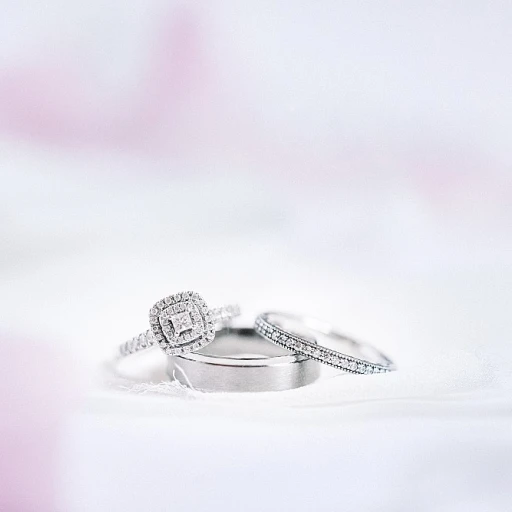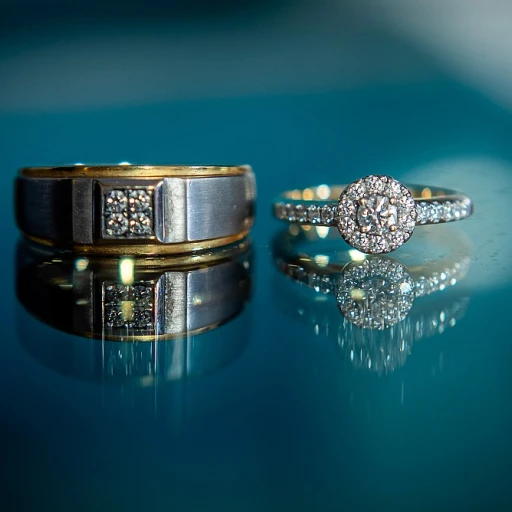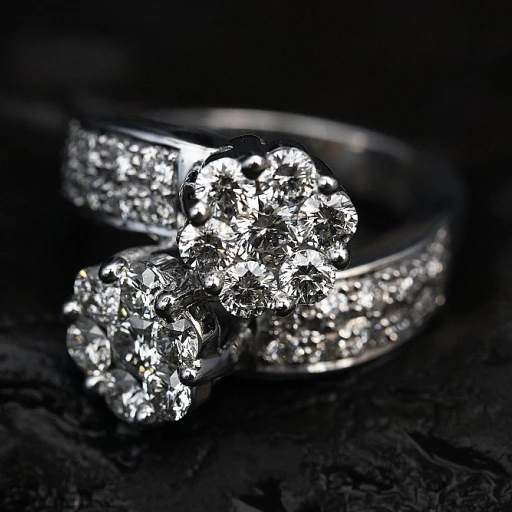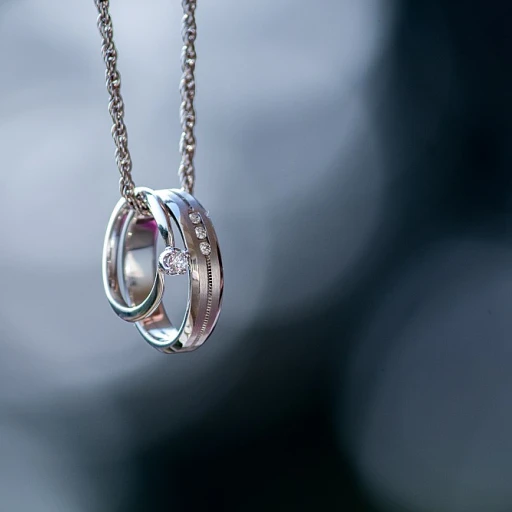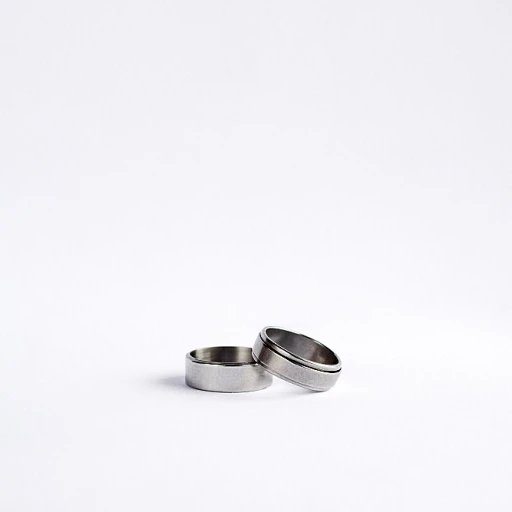Understanding Ring Resizing: A Detailed Guide
The Intricacies of Ring Resizing Explained
Ring resizing is an indispensable consideration for the perfect wedding ring journey. This nuanced craft ensures your band fits seamlessly throughout various life stages. According to a recent industry survey, nearly 35% of ring wearers will experience a change in ring size over their lifetime (JewelryIndustryStatistics.com). The resizing process involves meticulously altering the circumference of a band to match the wearer's finger—a task requiring not only skill but also profound knowledge of materials.
Materials Matter: The Role of Metals in Resizing
Not all metals are created equal when it comes to resizing possibilities. Precious metals like gold, platinum, and silver are often praised for their malleability, simplifying the resizing process. The Jewelry Almanac cites that gold, being a softer metal, is resized with relative ease, a factor to consider when purchasing a ring (JewelryAlmanac.com). One should be cognizant of the metal's characteristics to ensure longevity and the ability to adapt to size changes.
Navigating the Resizing Process
The act of resizing can take many forms, from simple stretching to adding extra metal or even complete reconstruction. Expert jewelers suggest that rings can generally be made larger or smaller by one to two sizes without compromising the integrity of the design. However, going beyond this range often requires more complex interventions, as highlighted by an expert jeweler's quote:
"Expertly resizing a ring is a delicate balance between art and science, as it should invisibly maintain the ring's original beauty." – The Ring Reverie Quarterly
Moreover, specialty designs—such as those with pavé diamonds or intricate patterns—may present additional challenges and should be approached with caution. The introduction of heat and tools must be strategically executed to preserve every precious detail.
Understanding the Limits
Indeed, while resizing is often feasible, it is not always possible. Rings with full eternity designs or tension settings pose particular difficulties due to their continuous nature. Renowned jewelry publications point out that such designs have limited, if any, potential for resizing. The Jewelry Experts Journal reports that approximately 10% of all rings fall into this category (JewelryExpertsJournal.com). This underscores the importance of foresight when selecting a ring, especially if one anticipates significant changes in size.
Steps to a Successful Resizing
- Determine the need for resizing: Regularly measure finger size to detect changes.
- Consult with a professional: Seek a reputable jeweler with a proven track record in resizing.
- Evaluate the design: Some designs may require specialized treatment or may not be resizable at all.
- Understand the implications: Resizing can alter a ring's structural integrity and appearance if not done correctly.
Remember, the quest for the perfect fit might require patience and precision. This detail-oriented approach will safeguard your ring's enduring elegance and comfort, encapsulating the sentiment behind your cherished symbol of love and commitment.
When to Resize: Timing and Life Events
Identifying the Right Moment for Ring Adjustment
Embarking on the journey of marriage, choosing wedding rings symbolizes a milestone like no other. But as life unfolds, the need for resizing your cherished band might arise. Events such as weight fluctuations, pregnancy, or changes in climate can affect how your ring fits. According to a survey by The Knot, an estimated 35% of married individuals have resized their ring due to weight change. Therefore, being strategic about timing can preserve not only the form but also the comfort of your betrothal token.
- Post-pregnancy
- Weight loss or gain
- Arthritis or other medical conditions affecting joints
Life Stages and the Impact on Your Wedding Band
Life's roller coaster ride demands adaptability, and your wedding ring should be no exception. Bestowing attention toward the condition of your ring can be an insight into self-care. For instance, a recent study revealed that 10% of people over the age of 40 experience alterations in finger size due to arthritis. Recognizing such changes and opting for a resizing can translate into enduring comfort and a reminder of constant love.
Strategic Resizing Around Life-Altering Events
'The essence of eternal commitment is not only about saying 'I do' but also about adapting to life's symphony together,' shares renowned ring artisan, Johnathon James. Seasonal shifts may also necessitate adjustments, as fingers tend to swell in warmer weather. Additionally, neurotransmitters released during intense exercise can cause temporary swelling, making the post-workout period less optimal for resizing. Hence, picking a serene moment when your body is at its most stable can make a world of difference in securing that perfect fit.
Understanding Resizing for the Right Reasons
The symbolism that a wedding ring holds is as significant as ensuring its correct size. It's not just about comfort; it's about signifying a bond that adeptly morphs with your life. Before deciding when to resize, ponder over the substantial reasons behind the need. 'Analyze your lifestyle and plan for a resize when it echoes the stable periods of your life,' suggests Elizabeth Stone, author of 'Eternal Bands: The Journey of Marriage and Jewelry'. From desk job sedentism to active lifestyles, each scenario demands thoughtful consideration in the quest for an impeccable fit.
Choosing a Resizable Ring: Materials and Designs
Identify Resizable Wedding Ring Designs
Picking the perfect wedding ring is both an act of love and a strategic decision. Couples should consider not only their immediate preferences but also the long-term flexibility of their rings. Certain materials and designs lend themselves to easier resizing. For instance, a plain gold band can typically be resized with minimal effort, as gold is a malleable metal. In contrast, rings with full eternity bands studded with diamonds are often challenging to alter without disturbing the setting—something to bear in mind when about 30% of married people require resizing within five years of marriage.
Similarly, materials like tungsten or ceramic are notably difficult or impossible to resize due to their hardness and potential to crack during the process. Couples who favor durability but seek resizing flexibility might opt for platinum, which marries the two characteristics successfully. It is always advisable to consult with jewelers, as their expertise can guide you towards rings known for adaptability.
Assessing the Impact of Ring Composition on Resizing
- Pure Metals: Easier to resize, but more prone to wear and tear
- Alloys: Often more durable, but can be trickier to manipulate
- Accent Stones: Can complicate resizing, requiring more care and possibly reconstruction of the ring's setting
When considering the composition, remember that according to The Knot's real weddings study, the average engagement ring cost hovers around $6,000, indicating an investment in both emotion and economics. Future compatibility with life changes, such as pregnancy or weight fluctuation, which affect nearly 60% of women and 45% of men, should be factored into the initial purchase.
Navigating the Resizing Limitations of Intricate Designs
Intricate designs, though stunning, come with a caveat: their resizing is often a delicate dance. Rings with intricate filigree or antique settings require a seasoned jeweler’s touch. The decision between a breathtaking design and one with simplicity that accommodates future resizing underscore the personal nature of wedding jewelry selections. Such designs may limit resizing options or, in some cases according to industry experts, allow for only one to two sizes of adjustment. Considering that weight gain or loss can fluctuate ring sizes by more than that over a lifetime, selecting a ring that harmonizes aesthetic desires with practicality is key.
Choosing a resizable ring doesn't mean compromising on style. Many jewelers now offer rings that pair customizable elements such as removable bands or adjustable settings that ensure the fit remains perfect over time. These innovative designs offer adaptability without foregoing the emotional significance of a ring's continuity on one's finger.
The Cost of Resizing: Factors and Considerations
Understanding the Price Spectrum of Ring Resizing
Navigating the landscape of wedding ring resizing can often lead to one foremost question: how much does it cost to resize a wedding ring? The answer isn’t as straightforward as one might hope. Statistics indicate that on average, ring resizing can cost anywhere from $20 to $150, with complex jobs costing up to $400 or more. However, key factors influence this cost, and the variance is attributed to aspects like the ring material, intricacy of the design, and the extent of resizing needed.
The Influencers of Resizing Expenditure
- Ring Material: Precious metals like gold and platinum are often more costly to resize due to their value and the labor involved. For instance, resizing a platinum band can cost up to 50% more than resizing a similar gold ring.
- Design Complexity: Rings with intricate patterns or stones may require additional labor, elevating the cost. Additionally, eternity bands with continuous settings may not be resizable or may incur hefty fees due to their complexity.
- Extent of Resizing: The more significant the change in size, the more labor-intensive and expensive the process becomes. If a ring requires stretching, it can typically only be done for a half-size. Beyond that, adding extra metal is often necessary, further impacting the final price.
- Geographical Location: Your locality can play a pivotal role in the cost of services. Jewelers in metropolitan areas often charge more for resizing compared to those in smaller towns or rural areas.
Ways to Minimize Ring Resizing Costs
Seeking ways to reduce the financial burden of resizing is paramount for many. For couples, considering rings designed with future resizing in mind can be a strategic move. Opting for rings with thicker bands and less ornamentation can also lower costs down the line. Should the need for resizing arise, quotes from several professional jewelers should be gathered, along with reviews to ensure quality craftsmanship. Moreover, some insurance policies cover resizing, so exploring bridal jewelry insurance with a resizing clause could be strategic for future married life.
Investment or Expense: The Perspective of Wedding Ring Resizing
To many, the cost of resizing a wedding ring may initially seem like yet another expense in the expansive scope of marital commitments. However, it is imperative to view it as an investment in comfort and the ring's longevity. With the understanding that a well-fitting ring is crucial to preventing loss or damage, allocating funds for potential resizing becomes an extension of caring for a precious symbol of your union. And while options like temporary ring adjusters exist, they serve as a band-aid solution rather than a sustainable, long-term fix.
Resizing and Its Impact on Value
Lastly, couples should be aware that while resizing is a common practice, it may affect the ring’s value and integrity. A professional appraiser can offer guidance on preserving the ring's value post-resizing. It is also essential to know that some jewelers offer a lifetime resizing policy, which may cost more upfront but can significantly save money over time.
Professional vs. DIY Resizing: Analyzing Your Options
The Debate: Professional Ring Resizing vs. DIY Solutions
When faced with the need to adjust your wedding ring, you're presented with a choice: professional resizing or the DIY route. It's crucial to weigh the pros and cons, as each option comes with its unique set of considerations. While professional resizing is generally recommended, there are cases where DIY solutions might seem appealing. This section provides an analytical view on both, ensuring you make an informed decision that will preserve the integrity of your ring through various life changes.
Deciphering the Professional Approach
Professional resizing, done by a skilled jeweler, ensures that your wedding ring is adjusted with precision and care. The process involves intricate craftsmanship and specialized tools. Statistics show that a significant percentage of people who opt for professional resizing appreciate the peace of mind it brings. One important factor to consider is the type of metal; platinum rings, for instance, require a higher level of expertise due to their density. Moreover, unique designs or rings with intricate patterns might not be suitable for DIY methods, as they require a delicate hand to maintain their original beauty.
Costing the Craftsmanship: Price Points of Professional Resizing
Pulling from previous sections on resizing costs, it's apparent that the price can vary widely. Several factors influence the cost of having your ring resized by a professional. The complexity of the job, the type of metal, and the addition or subtraction of material all come into play. According to industry data, a simple sizing down might cost between $20-$40, whereas sizing up a gold ring could be upward of $50, depending on the amount of gold required.
DIY Ring Resizing: Examining the Risks and Rewards
For those considering the DIY approach to wedding ring resizing, there's a wealth of instructional content available. However, it's important to proceed with caution. Ill-fitting rings not only prove uncomfortable but may also lead to loss or damage. While there are temporary solutions like ring adjusters or resizing liquids, these can often look unsightly or feel unnatural. Moreover, without the proper knowledge and equipment, one could inadvertently compromise the structural integrity of the ring. The choice to pursue a DIY solution should be made with a grain of salt, with a clear understanding of the temporary nature and potential pitfalls of the result.
Navigating Your Resizing Options with Confidence
Choosing between professional resizing and DIY methods involves a careful analysis of your specific situation. Personal stories and testimonials often underscore the satisfaction of a professional job well done, citing not only the ring's perfect fit but also the preservation of its aesthetic. Meanwhile, others have found short-term, cost-effective solutions with DIY methods. Industry experts agree, however, that for long-term satisfaction and to ensure the enduring value of your wedding ring, professional resizing is the safer bet. As you consider which path to take, reflect on these insights and choose wisely for your cherished symbol of love.


